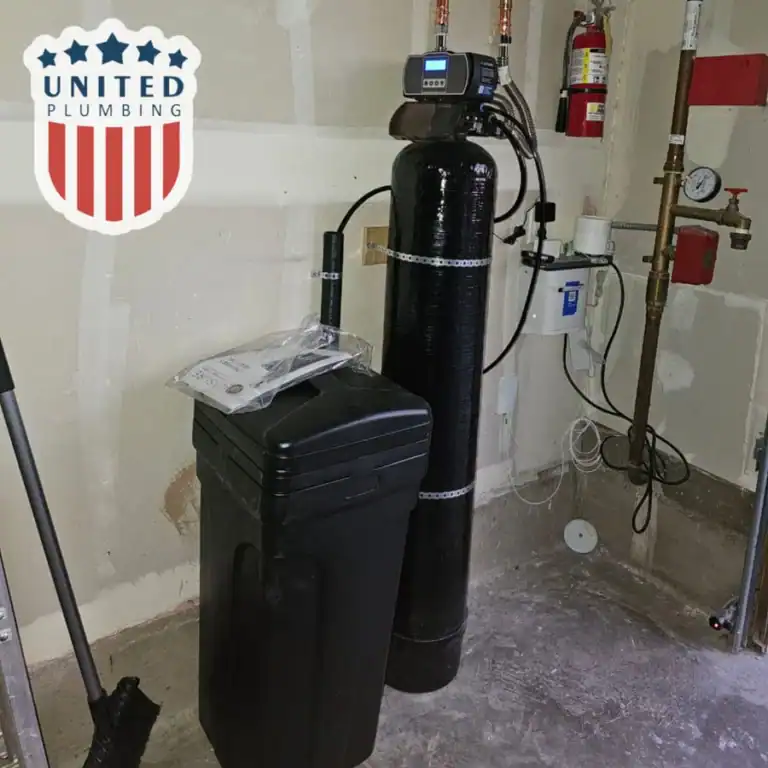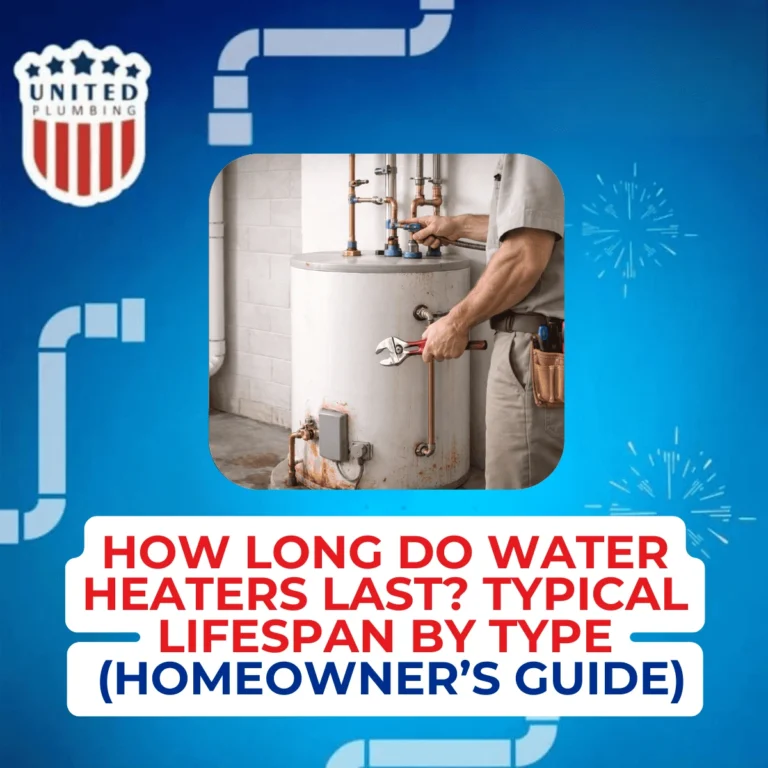FIVE-STAR TEAM WARRANTY &
SAME-DAY SERVICE
How to Size a Water Softener
Your water heater failed six months early due to hard water turned it into a mineral museum. Every faucet looks like it’s covered in chalk, your hair feels like rope no matter what conditioner you use, and cleaning soap scum takes a jackhammer. You’ve finally decided to fight back with a water softener, but here’s the catch—buy the wrong size and you’ll trade one set of problems for another.
Why Sizing a Water Softener Correctly Matters
Wrong water softener size means problems you didn’t expect. Too small and you’ll run out of soft water every morning when everyone showers. Too big and you’re wasting money on salt for capacity you’ll never use.
Undersized systems work their guts out and still fail. They regenerate every night, burn through salt bags constantly, and leave you with the same crusty buildup you started with. You’ll spend more on salt and repairs than you saved buying the smaller unit.
Oversized systems create different headaches. They regenerate so rarely that nasty stuff grows in the resin tank. Salt efficiency goes out the window because you’re using way more salt per gallon than necessary. Plus you paid premium prices for capacity that sits empty.
Get sizing right and your system regenerates every few days, uses salt efficiently, and delivers consistent soft water regardless of whether you’re using 100 gallons or 400 gallons. You solve hard water problems without creating expensive new ones.

Key Factors in Water Softener Sizing
Three factors determine what size you actually need. Mess up any one and you’re guaranteed frustration.
Water Hardness Level
Water hardness measures dissolved calcium and magnesium in grains per gallon (gpg). Your water company publishes this number in annual reports buried in legal-sized pages nobody reads. Well owners need professional testing because hardness fluctuates seasonally.
Most Americans deal with 7-15 gpg, though some regions get hammered with 25+ gpg levels requiring serious equipment. The harder your water, the bigger system you need to handle the mineral load.
Iron complicates hardness calculations because it acts like calcium in your softener. Add 3 grains to your hardness for every 1 ppm of iron. Ignore this and wonder why your system can’t handle seemingly moderate hardness levels.
Number of People in the Household
Standard estimates assume 70-80 gallons per person daily, but real households don’t follow textbook patterns. Teenagers shower for thirty minutes. College kids wash clothes constantly. Retired couples barely hit 150 gallons combined.
Count current residents, then consider changes within the next few years. Kids coming home from college, new babies, elderly parents moving in—all dramatically affect usage. Size for expected household composition, not just today’s residents.
Frequent guests matter for sizing calculations. Households hosting regular gatherings or weekend visitors need extra capacity for temporary spikes that double normal consumption.
Daily Water Usage
Check actual water bills instead of guessing based on household size. Look at several months to identify patterns and peak usage periods. Winter differs from summer, and holidays often spike consumption dramatically.
High-efficiency appliances use less water than older models, but luxury features offset savings. Multiple shower heads, big soaking tubs, and premium washing machines all increase daily totals significantly.
Exclude outdoor irrigation from sizing calculations unless your softener treats landscape water. Most installations only soften indoor usage, making sprinkler systems irrelevant.

Understanding Water Softener Capacity
Capacity measures grains of hardness minerals removed before regeneration becomes necessary.
What Is Grain Capacity?
Residential systems typically range from 24,000 grains for small households to 80,000+ grains for large families. Manufacturers test under perfect laboratory conditions that don’t exist in real installations.
Expect actual capacity around 75% of advertised ratings due to temperature variations, iron content, and flow fluctuations. A 32,000-grain system delivers roughly 24,000 grains of usable capacity in real-world conditions.
Salt dosage significantly affects actual capacity. Heavy doses increase grain removal but waste salt and reduce efficiency. Light doses improve efficiency but limit total capacity between regenerations.
Salt Efficiency and Regeneration Frequency
Salt efficiency measures grains removed per pound of salt consumed during regeneration. Efficient systems cost less to operate but may sacrifice some total capacity.
Regeneration frequency balances convenience with operating costs. Daily regeneration ensures consistent quality but wastes salt and water. Weekly regeneration improves efficiency but risks hardness breakthrough during heavy usage periods.
Modern controllers monitor consumption and initiate regeneration based on remaining capacity rather than arbitrary schedules. This approach optimizes efficiency while maintaining consistent performance.

Water Softener Sizing Chart by Household Size
Use these guidelines as starting points, then adjust for your specific conditions:
1-2 People: Very Hard (15+ gpg): 32,000-40,000 grains Moderate Hard (7-12 gpg): 24,000-32,000 grains
3-4 People: Very Hard (15+ gpg): 40,000-48,000 grains Moderate Hard (7-12 gpg): 32,000-40,000 grains
5-6 People: Very Hard (15+ gpg): 48,000-64,000 grains Moderate Hard (7-12 gpg): 40,000-48,000 grains
7+ People: Very Hard (15+ gpg): 64,000+ grains Moderate Hard (7-12 gpg): 48,000-64,000 grains
High usage, multiple bathrooms, or unusual consumption patterns may require larger systems regardless of family size.
Best Water Softener Models for Various Home Sizes
Different living situations need different approaches based on space constraints and performance requirements.
Compact Water Softeners for Apartments
Space-limited installations benefit from cabinet-style units combining controls and salt storage. These maximize functionality while minimizing floor space requirements in cramped utility areas.
24,000-32,000 grain systems handle apartments and small homes with 1-3 residents adequately. Compact designs fit tight spaces while delivering sufficient performance for normal household needs.
High-Capacity Water Softeners for Large Homes
Large households need robust systems handling high flow rates and extended usage periods without performance degradation.
48,000+ grain systems provide adequate capacity for families of five or more, especially in extremely hard water regions requiring frequent regeneration cycles.
Twin-tank systems eliminate soft water interruptions by alternating service between tanks during regeneration. One tank serves the house while the other regenerates, ensuring continuous availability.
Still confused about requirements? United HVAC, Plumbing & Electrical provides professional water testing and sizing consultation for optimal system selection.
Conclusion
Sizing a water softener correctly requires balancing actual water usage, hardness levels, and realistic budget constraints. Professional testing provides accurate hardness data while honest usage assessment ensures adequate capacity for peak demand periods.
Generic water softener size chart recommendations provide starting points, but individual situations often require adjustments based on specific usage patterns. Slight oversizing typically beats undersizing, though excessive oversizing wastes money through reduced efficiency.
Success depends on understanding your household’s unique requirements rather than accepting sales pitches or generic recommendations. Invest time gathering accurate data before making this significant purchase decision.
Ready to eliminate hard water problems permanently? Contact United HVAC, Plumbing & Electrical for professional testing, expert sizing consultation, and quality installation ensuring optimal performance and longevity.
Post views: 816
FAQ
How do I calculate the correct size water softener?
Multiply water hardness (gpg) by daily usage (gallons) for daily grain removal needed. Multiply by 7-10 days for total capacity. Example: 12 gpg × 280 gallons daily × 7 days = 23,520 grains minimum.
What happens if I choose a water softener that's too small?
Undersized systems regenerate constantly, waste salt and water, and produce hard water breakthrough during peak usage. You’ll experience inconsistent quality and excessive costs while failing to solve original problems.
Can a large water softener be bad for my home?
Oversized systems regenerate infrequently, allowing bacterial growth in stagnant resin. They consume more salt per gallon treated and cost significantly more upfront for unused capacity.
How often should a water softener regenerate?
Most residential systems regenerate every 3-7 days depending on capacity, usage, and hardness levels. Daily regeneration suggests undersizing, while 10+ day intervals may indicate oversizing or low consumption.
Latest posts

How Long Do Water Heaters Last? Typical Lifespan by Type (Homeowner’s Guide)
Your water heater works quietly behind the scenes every single day until one day it doesn’t. One of the most common...

Electrical Panel Upgrade California: Costs, Safety & When You Need One
An electrical panel upgrade in California is one of the most important safety and performance improvements a...


If you still have questions or need advice, please leave a request and we will contact you as soon as possible
Need a plumber and got no clue where to start?
(408) 539-6936Facing a plumbing issue? Get a FREE in-person estimate and quick solutions from our skilled technicians, ensuring your home runs smoothly again!
